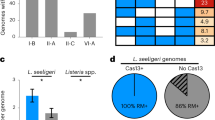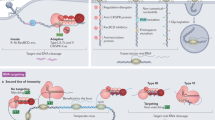Abstract
Bacteria evolved restriction endonucleases to prevent interspecies DNA transmission and bacteriophage infection. Here we show that human cells possess an analogous mechanism. APOBEC3A is induced by interferon following DNA detection, and it deaminates foreign double-stranded DNA cytidines to uridines. These atypical DNA nucleosides are converted by the uracil DNA glycosylase UNG2 to abasic lesions, which lead to foreign DNA degradation. This mechanism is evident in cell lines and primary monocytes, where up to 97% of cytidines in foreign DNA are deaminated. In contrast, cellular genomic DNA appears unaffected. Several other APOBEC3s also restrict foreign gene transfer. Related proteins exist in all vertebrates, indicating that foreign DNA restriction may be a conserved innate immune defense mechanism. The efficiency and fidelity of genetic engineering, gene therapy, and DNA vaccination are likely to be influenced by this anti-DNA defense system.
This is a preview of subscription content, access via your institution
Access options
Subscribe to this journal
Receive 12 print issues and online access
$189.00 per year
only $15.75 per issue
Buy this article
- Purchase on Springer Link
- Instant access to full article PDF
Prices may be subject to local taxes which are calculated during checkout







Similar content being viewed by others
References
Medzhitov, R. Recognition of microorganisms and activation of the immune response. Nature 449, 819–826 (2007).
Uematsu, S. & Akira, S. Toll-like receptors and type I interferons. J. Biol. Chem. 282, 15319–15323 (2007).
Takaoka, A. et al. DAI (DLM-1/ZBP1) is a cytosolic DNA sensor and an activator of innate immune response. Nature 448, 501–505 (2007).
Roberts, T.L. et al. HIN-200 proteins regulate caspase activation in response to foreign cytoplasmic DNA. Science 323, 1057–1060 (2009).
Burckstummer, T. et al. An orthogonal proteomic-genomic screen identifies AIM2 as a cytoplasmic DNA sensor for the inflammasome. Nat. Immunol. 10, 266–272 (2009).
Fernandes-Alnemri, T., Yu, J.W., Datta, P., Wu, J. & Alnemri, E.S. AIM2 activates the inflammasome and cell death in response to cytoplasmic DNA. Nature 458, 509–513 (2009).
Hornung, V. et al. AIM2 recognizes cytosolic dsDNA and forms a caspase-1-activating inflammasome with ASC. Nature 458, 514–518 (2009).
Chiu, Y.H., Macmillan, J.B. & Chen, Z.J. RNA polymerase III detects cytosolic DNA and induces type I interferons through the RIG-I pathway. Cell 138, 576–591 (2009).
Sadler, A.J. & Williams, B.R. Interferon-inducible antiviral effectors. Nat. Rev. Immunol. 8, 559–568 (2008).
Neil, S.J., Zang, T. & Bieniasz, P.D. Tetherin inhibits retrovirus release and is antagonized by HIV-1 Vpu. Nature 451, 425–430 (2008).
Van Damme, N. et al. The interferon-induced protein BST-2 restricts HIV-1 release and is downregulated from the cell surface by the viral Vpu protein. Cell Host Microbe 3, 245–252 (2008).
Roberts, W.K., Hovanessian, A., Brown, R.E., Clemens, M.J. & Kerr, I.M. Interferon-mediated protein kinase and low-molecular-weight inhibitor of protein synthesis. Nature 264, 477–480 (1976).
Kerr, I.M., Brown, R.E. & Hovanessian, A.G. Nature of inhibitor of cell-free protein synthesis formed in response to interferon and double-stranded RNA. Nature 268, 540–542 (1977).
Meurs, E. et al. Molecular cloning and characterization of the human double-stranded RNA-activated protein kinase induced by interferon. Cell 62, 379–390 (1990).
Bass, B.L. & Weintraub, H. An unwinding activity that covalently modifies its double-stranded RNA substrate. Cell 55, 1089–1098 (1988).
Di Noia, J.M. & Neuberger, M.S. Molecular mechanisms of antibody somatic hypermutation. Annu. Rev. Biochem. 76, 1–22 (2007).
Longerich, S., Basu, U., Alt, F. & Storb, U. AID in somatic hypermutation and class switch recombination. Curr. Opin. Immunol. 18, 164–174 (2006).
Chiu, Y.L. & Greene, W.C. The APOBEC3 cytidine deaminases: an innate defensive network opposing exogenous retroviruses and endogenous retroelements. Annu. Rev. Immunol. 26, 317–353 (2008).
Malim, M.H. & Emerman, M. HIV-1 accessory proteins–ensuring viral survival in a hostile environment. Cell Host Microbe 3, 388–398 (2008).
Bishop, K.N. et al. Cytidine deamination of retroviral DNA by diverse APOBEC proteins. Curr. Biol. 14, 1392–1396 (2004).
Bogerd, H.P., Wiegand, H.L., Doehle, B.P., Lueders, K.K. & Cullen, B.R. APOBEC3A and APOBEC3B are potent inhibitors of LTR-retrotransposon function in human cells. Nucleic Acids Res. 34, 89–95 (2006).
Bogerd, H.P. et al. Cellular inhibitors of long interspersed element 1 and Alu retrotransposition. Proc. Natl. Acad. Sci. USA 103, 8780–8785 (2006).
Muckenfuss, H. et al. APOBEC3 proteins inhibit human LINE-1 retrotransposition. J. Biol. Chem. 281, 22161–22172 (2006).
Chiu, Y.L. et al. High-molecular-mass APOBEC3G complexes restrict Alu retrotransposition. Proc. Natl. Acad. Sci. USA 103, 15588–15593 (2006).
Chen, H. et al. APOBEC3A is a potent inhibitor of adeno-associated virus and retrotransposons. Curr. Biol. 16, 480–485 (2006).
Narvaiza, I. et al. Deaminase-independent inhibition of parvoviruses by the APOBEC3A cytidine deaminase. PLoS Pathog. 5, e1000439 (2009).
Vartanian, J.P., Guétard, D., Henry, M. & Wain-Hobson, S. Evidence for editing of human papillomavirus DNA by APOBEC3 in benign and precancerous lesions. Science 320, 230–233 (2008).
Suspène, R. et al. Extensive editing of both hepatitis B virus DNA strands by APOBEC3 cytidine deaminases in vitro and in vivo. Proc. Natl. Acad. Sci. USA 102, 8321–8326 (2005).
Peng, G. et al. Myeloid differentiation and susceptibility to HIV-1 are linked to APOBEC3 expression. Blood 110, 393–400 (2007).
Tanaka, Y. et al. Anti-viral protein APOBEC3G is induced by interferon-α stimulation in human hepatocytes. Biochem. Biophys. Res. Commun. 341, 314–319 (2006).
Bonvin, M. et al. Interferon-inducible expression of APOBEC3 editing enzymes in human hepatocytes and inhibition of hepatitis B virus replication. Hepatology 43, 1364–1374 (2006).
Koning, F.A. et al. Defining APOBEC3 expression patterns in human tissues and hematopoietic cell subsets. J. Virol. 83, 9474–9485 (2009).
Peng, G., Lei, K.J., Jin, W., Greenwell-Wild, T. & Wahl, S.M. Induction of APOBEC3 family proteins, a defensive maneuver underlying interferon-induced anti–HIV-1 activity. J. Exp. Med. 203, 41–46 (2006).
Wang, F.X., Huang, J., Zhang, H., Ma, X. & Zhang, H. APOBEC3G upregulation by alpha interferon restricts human immunodeficiency virus type 1 infection in human peripheral plasmacytoid dendritic cells. J. Gen. Virol. 89, 722–730 (2008).
Conticello, S.G., Langlois, M.A., Yang, Z. & Neuberger, M.S. DNA deamination in immunity: AID in the context of its APOBEC relatives. Adv. Immunol. 94, 37–73 (2007).
LaRue, R.S. et al. The artiodactyl APOBEC3 innate immune repertoire shows evidence for a multi-functional domain organization that existed in the ancestor of placental mammals. BMC Mol. Biol. 9, 104 (2008).
Kavli, B., Otterlei, M., Slupphaug, G. & Krokan, H.E. Uracil in DNA–general mutagen, but normal intermediate in acquired immunity. DNA Repair (Amst.) 6, 505–516 (2007).
Aguiar, R.S., Lovsin, N., Tanuri, A. & Peterlin, B.M. Vpr.A3A chimera inhibits HIV replication. J. Biol. Chem. 283, 2518–2525 (2008).
Henry, M. et al. Genetic editing of HBV DNA by monodomain human APOBEC3 cytidine deaminases and the recombinant nature of APOBEC3G. PLoS One 4, e4277 (2009).
Di Noia, J. & Neuberger, M.S. Altering the pathway of immunoglobulin hypermutation by inhibiting uracil-DNA glycosylase. Nature 419, 43–48 (2002).
Suspène, R., Henry, M., Guillot, S., Wain-Hobson, S. & Vartanian, J.P. Recovery of APOBEC3-edited human immunodeficiency virus G→A hypermutants by differential DNA denaturation PCR. J. Gen. Virol. 86, 125–129 (2005).
Ishii, K.J. et al. A Toll-like receptor-independent antiviral response induced by double-stranded B-form DNA. Nat. Immunol. 7, 40–48 (2006).
Stetson, D.B. & Medzhitov, R. Recognition of cytosolic DNA activates an IRF3-dependent innate immune response. Immunity 24, 93–103 (2006).
Harris, R.S., Petersen-Mahrt, S.K. & Neuberger, M.S. RNA editing enzyme APOBEC1 and some of its homologs can act as DNA mutators. Mol. Cell 10, 1247–1253 (2002).
Jarmuz, A. et al. An anthropoid-specific locus of orphan C to U RNA-editing enzymes on chromosome 22. Genomics 79, 285–296 (2002).
Liddament, M.T., Brown, W.L., Schumacher, A.J. & Harris, R.S. APOBEC3F properties and hypermutation preferences indicate activity against HIV-1 in vivo. Curr. Biol. 14, 1385–1391 (2004).
Ivics, Z., Hackett, P.B., Plasterk, R.H. & Izsvák, Z. Molecular reconstruction of Sleeping Beauty, a Tc1-like transposon from fish, and its transposition in human cells. Cell 91, 501–510 (1997).
Ishii, K.J. & Akira, S. Innate immune recognition of, and regulation by, DNA. Trends Immunol. 27, 525–532 (2006).
Stetson, D.B., Ko, J.S., Heidmann, T. & Medzhitov, R. Trex1 prevents cell-intrinsic initiation of autoimmunity. Cell 134, 587–598 (2008).
Kawane, K. & Nagata, S. Nucleases in programmed cell death. Methods Enzymol. 442, 271–287 (2008).
Okabe, Y., Kawane, K., Akira, S., Taniguchi, T. & Nagata, S. Toll-like receptor-independent gene induction program activated by mammalian DNA escaped from apoptotic DNA degradation. J. Exp. Med. 202, 1333–1339 (2005).
Conticello, S.G., Thomas, C.J., Petersen-Mahrt, S. & Neuberger, M.S. Evolution of the AID/APOBEC family of polynucleotide (deoxy)cytidine deaminases. Mol. Biol. Evol. 22, 367–377 (2005).
Ewing, B., Hillier, L., Wendl, M.C. & Green, P. Base-calling of automated sequencer traces using phred. I. Accuracy assessment. Genome Res. 8, 175–185 (1998).
Acknowledgements
We thank J. Albin, J. Hultquist, D. Kaufman, L. Lackey and D. Trono for thoughtful feedback, P. Hackett and S. McIvor (University of Minnesota) for SB reagents, H. Bull (University of Saskatchewan) for help with antibody production, B. Thielen and J. Lingappa (Univ. of Washington) for sharing in vitro DNA deaminase assay protocols, M. Cornwell and J. Valesano for technical assistance, B. Cullen (Duke University), R. Tsien (University of California, San Diego), and J. DiNoia (Institut de recherches cliniques de Montréal) for plasmid constructs and J. Hanten (3M) for reagents and helpful discussions in the early stages of these studies. M.D.S. was supported in part by a 3M Graduate Fellowship and a Cancer Biology Training Grant (CA009138). M.B.B. was supported in part by the Children's Cancer Research Fund, Minneapolis, Minnesota, USA. This work was supported by grants from the US National Institutes of Health, GM090437 and AI064046.
Author information
Authors and Affiliations
Contributions
M.D.S. worked together with R.S.H. on all aspects of these studies and did most of the experiments; M.B.B. and M.L. established the TK mutation assay and the in vitro DNA deamination assays, respectively; J.L. performed the virus infectivity experiments.
Corresponding author
Ethics declarations
Competing interests
The authors declare no competing financial interests.
Supplementary information
Supplementary Text and Figures
Supplementary Figures 1–7, Supplementary Tables 1–4 and Supplementary Methods (PDF 1439 kb)
Rights and permissions
About this article
Cite this article
Stenglein, M., Burns, M., Li, M. et al. APOBEC3 proteins mediate the clearance of foreign DNA from human cells. Nat Struct Mol Biol 17, 222–229 (2010). https://doi.org/10.1038/nsmb.1744
Received:
Accepted:
Published:
Issue Date:
DOI: https://doi.org/10.1038/nsmb.1744
This article is cited by
-
Critical contribution of mitochondria in the development of cardiomyopathy linked to desmin mutation
Stem Cell Research & Therapy (2024)
-
Structure-guided inhibition of the cancer DNA-mutating enzyme APOBEC3A
Nature Communications (2023)
-
Research on the influence of APOBEC family on the occurrence, diagnosis, and treatment of various tumors
Journal of Cancer Research and Clinical Oncology (2023)
-
Mechanisms of APOBEC3 mutagenesis in human cancer cells
Nature (2022)
-
An extended APOBEC3A mutation signature in cancer
Nature Communications (2021)



